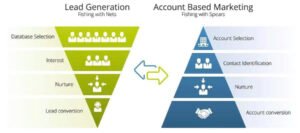
In today’s highly competitive B2B landscape, businesses are constantly looking for ways to personalize their marketing efforts and drive meaningful engagement. One approach gaining significant traction is account-based marketing (ABM). Unlike traditional B2B marketing, which casts a wide net to generate leads, ABM takes a more focused, strategic approach by targeting a specific set of high-value accounts. By aligning sales and marketing teams, ABM ensures that the right message reaches the right person at the right time, leading to stronger relationships and better conversion rates.
According to the Demand Metric “ABM Adoption Benchmark Report”, 60% of companies using ABM for at least a year reported increased revenue, demonstrating the tangible benefits of this approach.
How Does Account-Based Marketing Work?
At its core, ABM views each target account as a “market of one,” with personalized marketing efforts directed at key decision-makers within that account. Traditional B2B marketing campaigns aim to attract a broad audience, but ABM focuses on a few high-value prospects, delivering content and messaging that resonate with their specific needs.
Examples of ABM in action include sending highly personalized emails, offering exclusive content, or notifying key contacts about relevant events or offers. The goal is to create ongoing business relationships through tailored interactions that address the unique needs of each account.
However, ABM success depends on selecting the right accounts. Not every prospect qualifies for an ABM campaign. The ideal accounts are those with the highest revenue potential or strategic value to your business.

What Makes a Good ABM Account?
Choosing the right accounts for an ABM campaign is crucial, and it can be challenging for many marketers and sales professionals. While criteria may vary by industry, the following factors are key when identifying a good ABM account:
- Revenue potential: Since ABM campaigns require more resources, the selected accounts must have the potential to deliver a strong return on investment.
- Purchase history: Consider past interactions with your business and competitors.
- Sales funnel position: Target accounts that are actively moving through your sales pipeline.
- Ideal customer profile (ICP) alignment: The account should match your ICP, ensuring their needs align with your offerings.
It’s also important to assess whether the account will help you achieve specific business goals. For example, are you looking to engage with recognizable brands, re-establish relationships with lapsed accounts, or expand geographically? Identifying these factors will help narrow your focus to the accounts that matter most.
ABM vs. Lead Generation
While lead generation is a fundamental component of many marketing strategies, it takes on a different role in ABM. Lead generation typically involves attracting a broad range of prospects through various channels, such as email, social media, or events. In contrast, ABM focuses on generating leads within a narrow set of high-value accounts, aiming to engage multiple stakeholders within those accounts.
ABM narrows the focus to high-impact relationships, with the goal of expanding your influence within a target account and nurturing deeper engagement with different decision-makers.

The Role of Lead Scoring in ABM
Lead scoring is an essential element of account-based marketing. It involves ranking leads based on their likelihood to convert, using behavioral and engagement data to prioritize the most promising prospects within a target account. This allows marketing and sales teams to focus on leads that are most likely to take action, ensuring that resources are spent efficiently.
The Benefits of Account-Based Marketing
There are several key benefits to implementing an ABM strategy:
1. Sales and Marketing Alignment
ABM requires close coordination between sales and marketing teams. Both teams must align from the beginning to ensure that data-driven decisions are made throughout the sales cycle. This alignment leads to a more seamless and effective strategy, where both teams work together toward common goals.
2. Higher ROI
Because ABM is highly targeted and personalized, it tends to deliver a higher return on investment (ROI) than traditional B2B marketing efforts. Focusing on key accounts means fewer wasted resources and more meaningful engagements with decision-makers.
3. Shorter Sales Cycles
ABM accelerates the sales process by eliminating unqualified prospects early on. Since marketing efforts are directed only at accounts with the highest potential, sales teams can focus on nurturing those relationships, leading to faster conversions.
How to Develop a Successful ABM Campaign
To ensure a successful ABM campaign, follow these steps:
- Define Clear Goals: Start by setting your goals. Are you looking to increase revenue, build brand awareness, or re-engage lapsed clients? Once you’ve established clear objectives, create a plan of action with defined timelines, budgets, and KPIs.
- Select Target Accounts: Carefully select the accounts you want to target based on your ideal customer profile, revenue potential, and strategic value.
- Develop Stakeholder-Specific Content: Create personalized content and messaging tailored to each decision-maker within your target accounts. This could be industry-specific whitepapers, personalized emails, or exclusive invites to webinars.
- Deliver Personalized Messaging: Use a multi-channel approach to deliver timely, relevant messages to key influencers within your target accounts.
- Measure Results: Regularly review your campaign’s performance using KPIs like engagement rates, conversion rates, and pipeline velocity. Use these insights to optimize and adjust your strategy.
Key ABM KPIs to Track
- Marketing qualified leads/accounts
- Cost per lead
- Time on page (for digital asset engagement)
- Email open/reply rates
- Number of contacts engaged per account
- In-funnel conversion rate
- Sales meetings per account
- Close rate/churn rate
- Average deal size
The Role of Customer Data in ABM
Data is the backbone of a successful ABM strategy. To target the right accounts, you need to have accurate customer data, starting with an ideal customer profile (ICP). By analyzing past purchase behavior, revenue potential, and engagement, you can prioritize accounts that are most likely to convert.
You can also use data management platforms (DMPs) to identify anonymous users who have visited your digital assets. By activating this data, you can engage these users with personalized content and offers, moving them through the sales funnel.

How Content Marketing Works with ABM
Content is critical in ABM since everything is highly personalized. You’ll need to create industry-specific content and ensure it’s consistent across marketing and sales channels. The ultimate goal is to deliver the right content to the right people at the right time, maximizing engagement and improving conversion rates.
Conclusion
Account-based marketing offers a highly targeted, personalized approach to reaching high-value accounts. By aligning marketing and sales teams and focusing on specific accounts, ABM leads to higher ROI, shorter sales cycles, and better engagement with decision-makers. If you’re looking to improve your B2B marketing strategy, ABM is an effective way to achieve greater efficiency and drive meaningful business results.